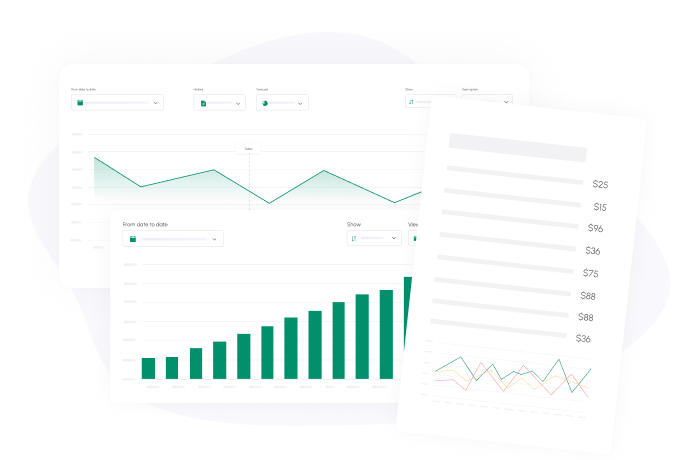

Financial modeling is a cornerstone of businesses worldwide. Understanding how a business’s finances evolve and grow will allow your company to make smarter, data-driven decisions. However, the way modeling is done today is rapidly evolving.
The Evolution of Financial Modelling
The future of finance has changed from spreadsheets to specialized software. Understanding how modeling was done in the past can help you better visualize its future.
Spreadsheet Era
Bookkeeping has a history dating back to 3200 BC. However, the spreadsheet software of today was first developed in 1979 with a product called VisiCalc. Accountants and business owners didn’t have access to:
- Microsoft Excel
- Google Sheets
Even cloud solutions, such as Google Sheets, weren’t released until 2006. You may even be using spreadsheets like this for your own business today. When you��’re just starting your operations, spreadsheets work well. In the long-term, these sheets can become very cumbersome when you have an immense amount of data to plug into the sheet.
Rise of Specialized Software
Strategic planning and forecasting are evolving into specialized software. Solutions like Cash Flow Frog allow you to:
- Connect to other data sources, such as QuickBooks
- Change simple variables and run cash flow forecasts and projections
- Run forecasts in-house without the need for an accountant
Utilizing specialized software empowers businesses to do more with their data than they’ve ever been able to do before. You can connect to multiple accounting solutions to view graphs and charts of how your finances change over a certain period of time.
Current Landscape of Financial Modeling Software
Financial modeling software today is filled with multiple features and options that work extremely well for small- and medium-sized businesses. Some of the many great features that you’ll gain access to include:
Features and Capabilities
Every financial software solution offers its own unique set of features and capabilities. You'll find that some of the most common features are:
- Integrations with other accounting solutions
- Cloud capabilities and backups
- User access controls
- Instant forecasts and projections
- Graphs and charting
However, you’ll find that there are just dozens and dozens of options with capabilities that are truly unique. You can do everything with accounting software, from managing cash flow to projecting sales and so much more.
Industry Adoption
Industry adoption is always crucial in the world of finance. While there are still accountants who are in their offices crunching numbers day and night, many have adopted software to help with everything from cash flow forecasting to trend analysis.
Sage Practice of Now found that 58% of businesses use some form of accounting software.
While there are not many newer stats, it’s likely that this figure will be much higher in 2023 than it was just three years ago. Interestingly, 82% of companies do use cloud solutions of some kind, so it’s safe to say that industry adoption for financial modeling software is relatively high.
The Power of Financial Modeling Software
Financial modeling tools are powerful because they present data faster than a human can. You can use real-time and frequent data for:
Improved Decision-making
Real-time data is invaluable. You'll have the ability to learn when cash flow is running low or sales are expected to rise higher than expected. Data is only valuable when you use it for decision-making.
For example, you can use the data that you learn from a cash flow forecast to:
- Secure financing
- Hire new employees
- Buy more supplies
If you expect a slow period due to the forecast, you can use it to make smarter decisions.
Strategic Planning and Forecasting
Planning and forecasting are not infallible, but they can help you spot trends in sales, cash flow, rising costs and more. You can use this information to plan for the future.
Data-Driven Insights
Again, data-driven insights are backed by data. You can use the data that you collect to run your business more efficiently and with fewer risks.
Challenges and Considerations
While financial modeling software offers many benefits and is a powerful solution for businesses, there are challenges and considerations that must be kept in mind.
Data Security and Privacy
One big concern with any software solution is data security and privacy. It’s important to ensure that the software you choose has built-in data protection and security features to prevent data breaches.
Skill Requirements
Financial modeling software can be complicated and often requires a steep learning curve. Consider what kind of training will be required and whether your staff will be able to manage the new software.
Future Trends and Innovations
The future of financial model software will likely involve artificial intelligence, simulations, blockchain and automation to make the process as streamlined and accurate as possible.
Artificial Intelligence and Machine Learning Integration
In the future, the best financial modeling software will likely rely on artificial intelligence (AI) and machine learning (ML). AI-based forecasts will be able to predict future company financials with even greater accuracy than traditional ones.
One advantage of AI and ML is that they can handle large volumes of data. AI forecasting models can also consider both internal and external factors, such as macroeconomic conditions and stock market conditions.
Another advantage of AI-powered forecasts is that they are self-learning. When the algorithm is fed new data, the AI model will reforecast and adjust automatically and with greater accuracy.
Predictive Analytics and Scenario Simulation
Predictive analytics uses statistical models that can incorporate trends with less manual effort. The process Is all about creating forecasts based on historical data.
Past events are analyzed using machine learning and statistical algorithms to produce predictions and probabilities.
Scenario simulation will also make it easier to predict the effects of decisions, so businesses can make smarter, data-backed choices.
Blockchain and Distributed Ledger Technology
Blockchain and distributed ledger technology will continue to permeate the financial industry and will undoubtedly affect financial modeling in the future.
Blockchain can streamline lending and banking services. It can also facilitate compliance by providing a secure record of transactions, making it easier to audit and monitor financial activities.
While blockchain and distributed ledger technology won’t necessarily affect financial modeling directly, it will have some impact on the process.
Conclusion
Financial modeling software helps streamline and automate the process of financial modeling. While these platforms offer many advantages, there are challenges that must be considered, as well as the future of financial modeling.
Related posts:
You may be interested:
New:












